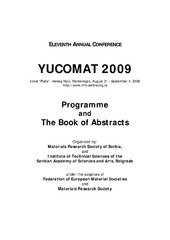Приказ основних података о документу
Precipitation Synthesis and Two-Step Sintering of Hydroxyapatite Nanopowders
| dc.creator | Lukić, Miodrag J. | |
| dc.creator | Marković, Smilja | |
| dc.creator | Ignjatović, Nenad | |
| dc.creator | Uskoković, Dragan | |
| dc.date.accessioned | 2023-08-21T09:30:18Z | |
| dc.date.available | 2023-08-21T09:30:18Z | |
| dc.date.issued | 2009 | |
| dc.identifier.isbn | 978-86-80321-18-9 | |
| dc.identifier.uri | https://dais.sanu.ac.rs/123456789/14836 | |
| dc.description.abstract | Hydroxyapatite, (HAp), Ca5(PO4)3(OH), due to its excellent biocompatibility and osteoconductivity as well as close similarity to human bone structure, represents a promising material for hard tissue implantation. However, mechanical properties of synthetic HAp are not so good as those of natural bones and that limits load-bearing application. Recently it was found that nanostructured ceramics have much better mechanical properties. The nanostructured ceramics could be obtained by two-step sintering technique. Of course, to have such final product, nanopowder as starting material is necessary. In this work, method of chemical precipitation was performed to prepare hydroxyapatite (HAp) nanopowders. The synthesis parameters, like concentration of starting solutions, speed of stirring, time of ageing, as well as time of ultrasound treatment of as-precipitated powders, were investigated in terms of particle size and particles size distribution. The obtained powders were characterized by X-ray diffraction (XRD), scanning electron microscopy (SEM) and particle size measurements. In order to suppress accelerated grain growth during final stage sintering and to maintain bioceramics nanostructured, with the most uniform grain size distribution, was treated by two-step sintering technique. The samples were uniaxially pressed into pellets and were first heated to the higher temperature T1 and attained at this for a short time, just to render pores unstable. After that, the sample was cooled down to the temperature T2 and kept for prolonged time. At the latter temperature densification should occur without grain growth because of difference in kinetics of desirable grain boundary diffusion and undesirable grain boundary migration. The best temperature range was determined by try and error method and master sintering curve in order to reach the highest possible density. | sr |
| dc.language.iso | en | sr |
| dc.publisher | Belgrade : Institute of Technical Sciences of SASA | sr |
| dc.relation | info:eu-repo/grantAgreement/MESTD/MPN2006-2010/142006/RS// | sr |
| dc.relation.isreferencedby | https://hdl.handle.net/21.15107/rcub_dais_268 | |
| dc.rights | openAccess | sr |
| dc.rights.uri | https://creativecommons.org/licenses/by/4.0/ | |
| dc.source | Programme and The Book of Abstracts / Eleventh Annual Conference YUCOMAT 2009, Herceg Novi, August 31 – September 4, 2009 | sr |
| dc.subject | two-step sintering | sr |
| dc.subject | hydroxyapatite | sr |
| dc.subject | nanopowders | sr |
| dc.subject | chemical precipitation | sr |
| dc.subject | ultrasonic processing | sr |
| dc.subject | grain boundary | sr |
| dc.title | Precipitation Synthesis and Two-Step Sintering of Hydroxyapatite Nanopowders | sr |
| dc.type | conferenceObject | sr |
| dc.rights.license | BY | sr |
| dc.citation.spage | 187 | |
| dc.citation.epage | 187 | |
| dc.description.other | Poster: [https://hdl.handle.net/21.15107/rcub_dais_268] | |
| dc.type.version | publishedVersion | sr |
| dc.identifier.fulltext | http://dais.sanu.ac.rs/bitstream/id/59459/bitstream_59459.pdf | |
| dc.identifier.rcub | https://hdl.handle.net/21.15107/rcub_dais_14836 |

